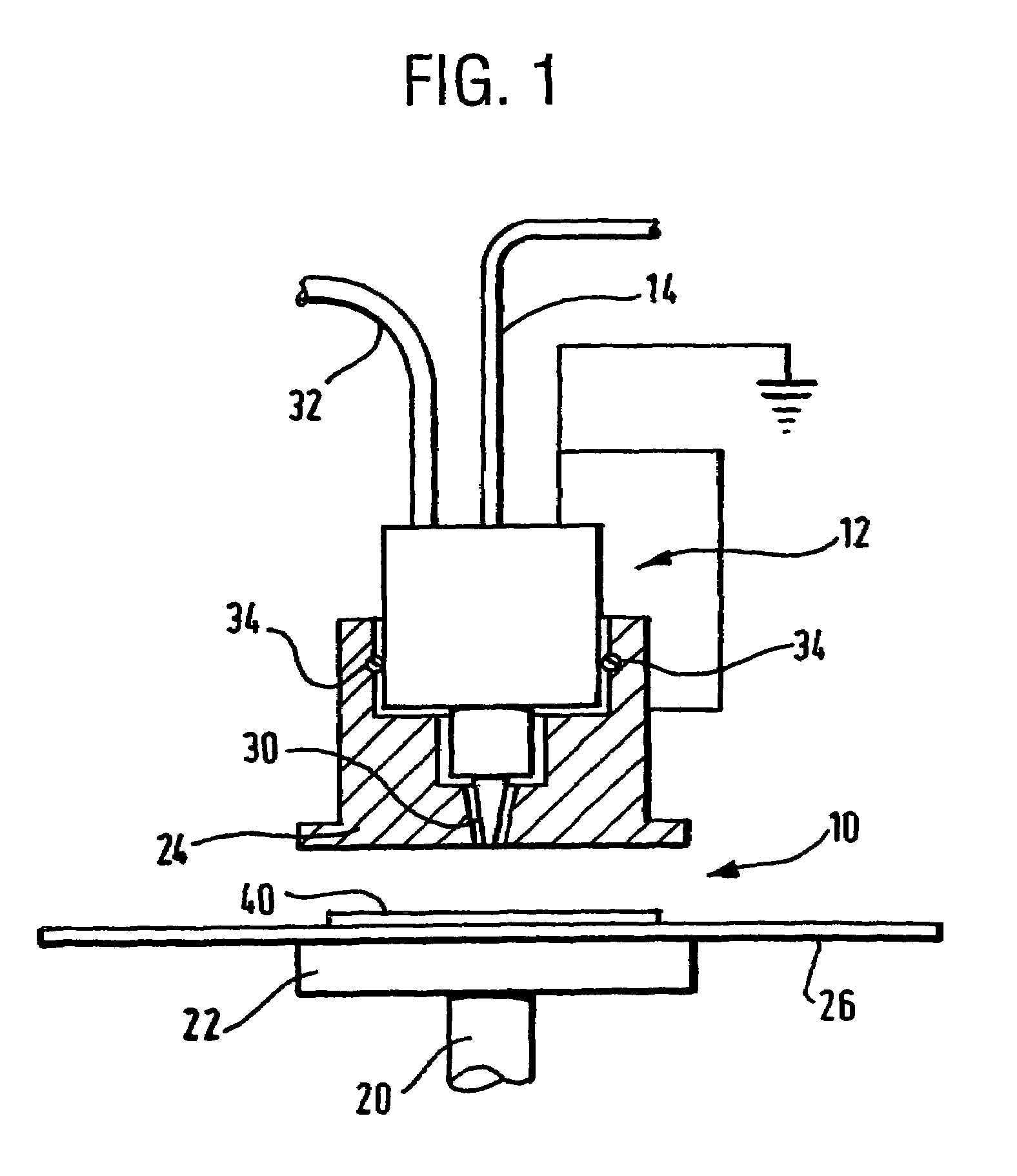Method and apparatus for forming a coating
a coating and coating technology, applied in the field of coating methods, can solve the problems of limited batch treatment and high surface treatment costs
- Summary
- Abstract
- Description
- Claims
- Application Information
AI Technical Summary
Benefits of technology
Problems solved by technology
Method used
Image
Examples
example 1
[0024]A piece of polyethylene film substrate was ultrasonically washed in a 1:1 mixture of isopropyl alcohol and cyclohexane and was placed on the glass plate. After evacuation of residual gas, the plasma discharge gas was introduced at a flow rate of 1900 sccm and a pressure of 1.02×105 Nm−2. Two discharge gasses were used, helium and a 99% helium / 1% oxygen mixture. After 10 minutes of purging, the syringe pump 14 was switched on and the coating-forming material was allowed to flow at a rate of 3×10−5 mls−1. Two coating-forming materials were used, octamethylcyclotetra-siloxane (hereinafter referred to as “D4”) and tetramethylcyclotetrasiloxane (hereinafter referred to as “D4H”). When the coating-forming material reached the ultrasonic nozzle, the ultrasonic generator was switched on (2.5 W) to initiate atomization of the coating-forming material, and the atmospheric pressure plasma discharge was ignited by applying 1.5 kV across the electrodes. Deposition of the coating-forming ma...
example 2
[0031]The method of Example 1 above was repeated using a glass substrate and acrylic acid as the coating-forming material, and helium alone as the discharge gas. The coating was removed from the substrate prior to analysis.
[0032]FTIR and solid state NMR analysis of the coating confirmed that the acrylic acid had polymerized to form polyacrylic acid. Both FTIR and NMR data showed consumption of the unsaturated C═C bond.
example 3
[0033]The method of Example 2 was repeated, but using nylon and polyethylene substrates.
[0034]An FTIR analysis comparison of the coating with commercially available polyacrylic acid confirmed that the acrylic acid coating-forming material had polymerized to form a polyacrylic acid coating on the substrate surfaces.
[0035]X-ray photoelectron spectroscopic analysis, film thickness analysis, and contact angle measurements were performed per Example 1 above. The results are shown in Table 3 below.
[0036]
TABLE 3ContactDepositionXPS analysisAnglerate% C% O% CO2H(°)(nms−1)Theory60.040.033.3——Commercial polyacrylic63.336.729.9wets—acidExample 3 coating62.637.426.4wets231 ± 95
[0037]Gas transport through the coated polyethylene film was determined by mass spectrometry, and the barrier improvement factor calculated per Example 1 above over an untreated polyethylene substrate and commercially available polyacrylic acid. The results are shown in Table 4 below.
[0038]
TABLE 4SampleBarrier Improvement...
PUM
| Property | Measurement | Unit |
|---|---|---|
| Pressure | aaaaa | aaaaa |
| Chemical properties | aaaaa | aaaaa |
| Exposure limit | aaaaa | aaaaa |
Abstract
Description
Claims
Application Information
 Login to View More
Login to View More - R&D
- Intellectual Property
- Life Sciences
- Materials
- Tech Scout
- Unparalleled Data Quality
- Higher Quality Content
- 60% Fewer Hallucinations
Browse by: Latest US Patents, China's latest patents, Technical Efficacy Thesaurus, Application Domain, Technology Topic, Popular Technical Reports.
© 2025 PatSnap. All rights reserved.Legal|Privacy policy|Modern Slavery Act Transparency Statement|Sitemap|About US| Contact US: help@patsnap.com


